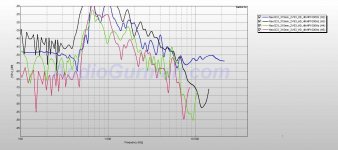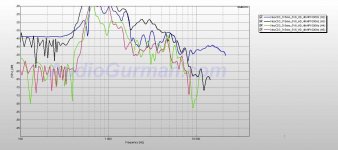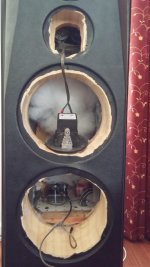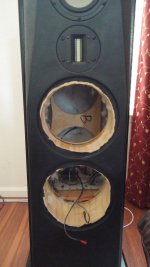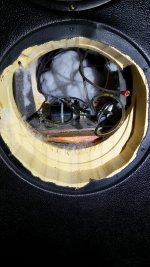My apologies on a detail that i got wrong.
The side subwoofers are actually 12" and NOT 10" as i initially posted.
The side subwoofers are actually 12" and NOT 10" as i initially posted.
Something is wrong here. IMO this need a redesign. The drivers are fine, besides the 10" which I would prefer to be 12" for them to match the 2x8". It is ok for the seas 8" to be in sligthly smaller enclosure, since they dont need to go deep, when having subs. But I think the following is needed to be done:
The subs are indeed 12" and not 10" as i initially posted.
1. Midrange is compromised in a 3" cylindrical tube.... simply not a good enclosure for midrange production. Better to have assymetrical deep cabinet and square.
What i meant was that the midrange driver mouting hole is not done well. There is no chamfering. Hence due to the 3" thickness of the baffle, it is almost equivalent to having a 3"tube on the rear of the driver before it opens into the midrange cabinet
2. Flush mount the drivers. Some drivers migth perform ok without bothering, but it can newer compromise the drivers performance, when flush mounted - so do it.
The drivers are flush mounted.
3. Subs - IMO - should be moved to the corners in seperate boxes and controlled actively. Sometimes it also helps to place them assymetrically so that they exite different room modes according to the layout of your listening room.
Agree to your comment. But doesn't seem like a feasible option for me immediately.
You can unfasten the drivers and disconnect them.
So can measure the frequency response of the single driver including the crossover.
Have you read the datasheet of the Fountek Neocd 3.0.
This driver can only be used above 4.0Khz.
Yes that could be the next step after doing whats possible with the binding posts.
Did you have a chance to looks at the plots that i attached?
Also in room measurements of the 8" will be any good?
Try first something very simple: another amplifier and or source/preamp.
Here's a description of the ATI amplifier that describes your problem.
With very transparent speakers you're hearing all the problems in the rest of the audio chain.
Thats a possibility though i will be very disappointed if thats true.
The ATIs and Yulong have good spec and reviews. They are not high end, but pretty much the best i can afford at this time. The only other options in my budget were NAD and Rotel
In any case i do think the speakers have their faults too
You can unfasten the drivers and disconnect them.
So can measure the frequency response of the single driver including the crossover.
Have you read the datasheet of the Fountek Neocd 3.0?
This driver can only be used above 4.0khHz.
I did hear the 5" mids playing pretty high. So they are likely crossing over to the ribbons pretty high. Though not sure how low the mids are going before the 8" take over
oops! I misread the part abuot the midrange. It is camfering you need. By all means the midrange need to be able to breath proberly - so thats a thing to be done for sure.
A trick to measure the drivers and the filters - could be to disconnect all drivers besides the one that you measure. Then you could get a response of each driver with they're filter attached. This would provide good info of how the "secret" filter is designed.
I would start by making sure that the 3 way part works probely first.
You might be able to aquire a big router bit, so that you could camfer the midrange baffle without taking it off. But it's a long shot and maybe not that easy or wise to do. Simply a shame that the guy constructing these, did not remember basic stuff like this 😕
Besides the finish.... which is allways the difficult thing IMO. I would build new boxes without the subs intergrated. Then you would know that it was done right. Maybe you could get someone with a CNC to "plow" of the front baffle and simply make a new one, that could save some work - but I'm just thinking out loud here 🙂 Most hifi buddys I know allways suggest to build a cheap box to begin with and forget about finish - until you a sure that the design will work according to plan. which could be wise to do when experimenting with corner subs.... not that you should.... well I think you should 😀
A trick to measure the drivers and the filters - could be to disconnect all drivers besides the one that you measure. Then you could get a response of each driver with they're filter attached. This would provide good info of how the "secret" filter is designed.
I would start by making sure that the 3 way part works probely first.
You might be able to aquire a big router bit, so that you could camfer the midrange baffle without taking it off. But it's a long shot and maybe not that easy or wise to do. Simply a shame that the guy constructing these, did not remember basic stuff like this 😕
Besides the finish.... which is allways the difficult thing IMO. I would build new boxes without the subs intergrated. Then you would know that it was done right. Maybe you could get someone with a CNC to "plow" of the front baffle and simply make a new one, that could save some work - but I'm just thinking out loud here 🙂 Most hifi buddys I know allways suggest to build a cheap box to begin with and forget about finish - until you a sure that the design will work according to plan. which could be wise to do when experimenting with corner subs.... not that you should.... well I think you should 😀
The ATIs and Yulong have good spec and reviews. They are not high end, but pretty much the best i can afford at this time.
Try to borrow another amplifier, at least then you'll know the effect of another amplifier in your audio system.
You stated that:
This is more like an amplifier/source problem.1. For slow classical music, instrumental etc these sound very good
2. Anything fast and complex like rock cause it to completely fall apart.
Sorry... I can see that someone else beat me to it again with the measuring trick and I also misread the part about flush mounting. I think my brain has not yeat woken up proberly on this calm sunny saturday. Hope that at least some of what I wrote will inspire or help you out. I will grab some coffee and go do something that require something less of me now 😀
The recommended upper crossover frequency of the 5" drivers is 3kHz -see datasheet here: http://www.seas.no/index.php?option...8s-w15cy001&catid=49:excel-woofers&Itemid=359
Last edited:
These suggest nothing is drastically wrong with the crossover although there may be a number of modest modifications that could add up to a significant improvement.some plots i could obtain:
Crossing a largish 5" metal midrange with severe cone breakup to a small ribbon strikes me as very difficult if not impossible to do successfully. I would suggest finding out what was done in the crossover, measure more on and off axis and particularly the distortion (should be fine in room at these frequencies). Then have a bit of a ponder about your options.
If bass is lacking then finding out what was done for "baffle step correction" in the crossover may be a good place to start. If you measure close to the woofers do you see a significant rise in the bass indicating the presence of such a correction?
If the woofers are moving together what proportion of a wavelength is the lower woofer from the midrange at the crossover?
Putting chamfering the baffles on the to-do list is probably a good idea if you can first diagnose what the problems are and add them to the to do list. I would be tempted to disable the subwoofers while trying to determine where the issues may lie.
Thank you all for some very thoughtful comments and advice.
There are many actions for me to pursue. As a first step i will try to see if there is a way for me to access the crossover and take pictures.
There are many actions for me to pursue. As a first step i will try to see if there is a way for me to access the crossover and take pictures.
That cabinet is gorgeous and deserves a properly designed crossover with appropriately selected drivers.
The idea behind the 4 way is interesting. A three way with sub is a classic, but in this case is rather strange. As has been said before the W22 drivers, when put into a suitable ported enclosure will put out pretty large amounts of bass. The 10" XLS drivers will also do the same, but not when put into a sealed cabinet. These are designed to work with their matching passive radiator and when run sealed need a bass boost to get their response to extend down low and then wont hit particularly high SPLs because of it. Still the concept is there. If you're going to have a three way + sub configuration you'd want to run the three way sealed to ease integration with the subs and to protect the three ways bass drivers from over-excursion.
The mentioned 3" tunnel that the midrange is sitting in isn't ideal and should really be altered. I don't think this would be enough to significantly affect the sound quality, but it is not ideal. If you cannot modify the cabinets to open up the rear of the driver then replacing the driver with the W15CH001 might be an idea. This is the W15CY001 but instead of the large ferrite magnet it has a small neo magnet and this would really help in opening up the rear of the driver.
Aside from that though the huge glaring issue is the NeoCD3.0, it is 100% NOT suited to this design. The W15 is an excellent driver but it needs a low xover point to work properly, a 4th order acoustic @ 2kHz is necessary to get the most out of it. If you cross over higher issues, because of the metal cone resonance, then start to creep in.
The NeoCD3.0 just does not have what the W15 requires to work properly. Now it has a 110mm cut out, which is quite difficult as most tweeters come with a 104mm cut out, still there are some out there, one of which is the T25CF001 tweeter from SEAS and this will work perfectly down to 2kHz to mate well with the W15. If you really want to make this design work properly then this is the one thing that you really need to do - replace the ribbon with a tweeter that can work with the W15.
Besides that all of the drivers need to be integrated well with regards to both magnitude and phase, ensuring that they are all working over their optimum ranges and crossed over so as to ensure a nice even off axis response.
I am sure there are things that can be done to improve the sound quality of the system as it stands, but really the ribbon needs to go.
Out of interest here are some distortion measurements of the ribbon. The first is done at a drive level of 2.83vRMS.

Here you can clearly see the distortion rising below 4kHz necessitating that the tweeter be used only with high crossover points.
Next is the tweeter tested at 5.6vRMS.

This is where things really get interesting as it shows what happens when the volume is turned up. Large three ways have the ability to play loud, so seeing how a tweeter response under duress is important. Here we see the performance literally fall to pieces, with the tweeter now needing a steep crossover at 6kHz to work acceptably. It is not a good choice for this loudspeaker.
The idea behind the 4 way is interesting. A three way with sub is a classic, but in this case is rather strange. As has been said before the W22 drivers, when put into a suitable ported enclosure will put out pretty large amounts of bass. The 10" XLS drivers will also do the same, but not when put into a sealed cabinet. These are designed to work with their matching passive radiator and when run sealed need a bass boost to get their response to extend down low and then wont hit particularly high SPLs because of it. Still the concept is there. If you're going to have a three way + sub configuration you'd want to run the three way sealed to ease integration with the subs and to protect the three ways bass drivers from over-excursion.
The mentioned 3" tunnel that the midrange is sitting in isn't ideal and should really be altered. I don't think this would be enough to significantly affect the sound quality, but it is not ideal. If you cannot modify the cabinets to open up the rear of the driver then replacing the driver with the W15CH001 might be an idea. This is the W15CY001 but instead of the large ferrite magnet it has a small neo magnet and this would really help in opening up the rear of the driver.
Aside from that though the huge glaring issue is the NeoCD3.0, it is 100% NOT suited to this design. The W15 is an excellent driver but it needs a low xover point to work properly, a 4th order acoustic @ 2kHz is necessary to get the most out of it. If you cross over higher issues, because of the metal cone resonance, then start to creep in.
The NeoCD3.0 just does not have what the W15 requires to work properly. Now it has a 110mm cut out, which is quite difficult as most tweeters come with a 104mm cut out, still there are some out there, one of which is the T25CF001 tweeter from SEAS and this will work perfectly down to 2kHz to mate well with the W15. If you really want to make this design work properly then this is the one thing that you really need to do - replace the ribbon with a tweeter that can work with the W15.
Besides that all of the drivers need to be integrated well with regards to both magnitude and phase, ensuring that they are all working over their optimum ranges and crossed over so as to ensure a nice even off axis response.
I am sure there are things that can be done to improve the sound quality of the system as it stands, but really the ribbon needs to go.
Out of interest here are some distortion measurements of the ribbon. The first is done at a drive level of 2.83vRMS.
Here you can clearly see the distortion rising below 4kHz necessitating that the tweeter be used only with high crossover points.
Next is the tweeter tested at 5.6vRMS.
This is where things really get interesting as it shows what happens when the volume is turned up. Large three ways have the ability to play loud, so seeing how a tweeter response under duress is important. Here we see the performance literally fall to pieces, with the tweeter now needing a steep crossover at 6kHz to work acceptably. It is not a good choice for this loudspeaker.
Attachments
That cabinet is gorgeous and deserves a properly designed crossover with appropriately selected drivers.
The idea behind the 4 way is interesting. A three way with sub is a classic, but in this case is rather strange. As has been said before the W22 drivers, when put into a suitable ported enclosure will put out pretty large amounts of bass. The 10" XLS drivers will also do the same, but not when put into a sealed cabinet. These are designed to work with their matching passive radiator and when run sealed need a bass boost to get their response to extend down low and then wont hit particularly high SPLs because of it. Still the concept is there. If you're going to have a three way + sub configuration you'd want to run the three way sealed to ease integration with the subs and to protect the three ways bass drivers from over-excursion.
The mentioned 3" tunnel that the midrange is sitting in isn't ideal and should really be altered. I don't think this would be enough to significantly affect the sound quality, but it is not ideal. If you cannot modify the cabinets to open up the rear of the driver then replacing the driver with the W15CH001 might be an idea. This is the W15CY001 but instead of the large ferrite magnet it has a small neo magnet and this would really help in opening up the rear of the driver.
Aside from that though the huge glaring issue is the NeoCD3.0, it is 100% NOT suited to this design. The W15 is an excellent driver but it needs a low xover point to work properly, a 4th order acoustic @ 2kHz is necessary to get the most out of it. If you cross over higher issues, because of the metal cone resonance, then start to creep in.
The NeoCD3.0 just does not have what the W15 requires to work properly. Now it has a 110mm cut out, which is quite difficult as most tweeters come with a 104mm cut out, still there are some out there, one of which is the T25CF001 tweeter from SEAS and this will work perfectly down to 2kHz to mate well with the W15. If you really want to make this design work properly then this is the one thing that you really need to do - replace the ribbon with a tweeter that can work with the W15.
Besides that all of the drivers need to be integrated well with regards to both magnitude and phase, ensuring that they are all working over their optimum ranges and crossed over so as to ensure a nice even off axis response.
I am sure there are things that can be done to improve the sound quality of the system as it stands, but really the ribbon needs to go.
Out of interest here are some distortion measurements of the ribbon. The first is done at a drive level of 2.83vRMS.
Here you can clearly see the distortion rising below 4kHz necessitating that the tweeter be used only with high crossover points.
Next is the tweeter tested at 5.6vRMS.
This is where things really get interesting as it shows what happens when the volume is turned up. Large three ways have the ability to play loud, so seeing how a tweeter response under duress is important. Here we see the performance literally fall to pieces, with the tweeter now needing a steep crossover at 6kHz to work acceptably. It is not a good choice for this loudspeaker.
Thanks for the detailed analysis.
I was unhappy with the Fountek, just didnt sound right to me.
Again i'm still learning here, so here is what i gathered from your description
1. It has too much distortion at most listening level and on its lower end
2. ideal Cross over point needed between this and the 5" mid dont suit either driver (this one was also pointed out by other comments)
What a disaster this design is 🙁
I picked up the speaker for about 1500USD, looking at the driver quality and the cabinet build quality. The quality of components in the crossover are top notch too. Unfortunately i need to throw it out of the window and rework to get any life into these beasts.
Summary of problems.
1. Fountek is hard to integrate well with the 5" mid
2. The 8"woofers are too wimpy in this design
3. Midrange mounting hole needs chamfering
1. Fountek is hard to integrate well with the 5" mid
2. The 8"woofers are too wimpy in this design
3. Midrange mounting hole needs chamfering
What a disaster this design is 🙁
I picked up the speaker for about 1500USD, looking at the driver quality and the cabinet build quality. The quality of components in the crossover are top notch too. Unfortunately i need to throw it out of the window and rework to get any life into these beasts.
A disaster is probably a bit strong but you have not got a bargain given the work required. You will need to modify the crossover and probably change the tweeter or the midrange. The former is likely to be the easiest and cheapest. You may also need to rework the low frequency end of the crossover if the perceived lack of bass is due to, for example, an overly small or missing baffle step correction.
I would suggest the first step is still to measure and understand what you have got and then to learn from the mistakes made by the previous owner in assuming very expensive components were the key to high sound quality. No reason it shouldn't be a rewarding exercise.
Just a thought but what volume would the main enclosure have if you added the subwoofer enclosure? And what volume would you need to port the woofers?
The woofers themselves are fine. My guess is the baffle step correction is missing or incorrect in the crossover but this is only a guess. To find out measure close to the woofers.2. The 8"woofers are too wimpy in this design
The woofers themselves are fine. My guess is the baffle step correction is missing or incorrect in the crossover but this is only a guess. To find out measure close to the woofers.
Yes agree. I did mean that the woofers as designed were not getting the best out of the drivers
Opened the cabinets up and took some photos. Will post shortly.
The work done on the baffle is absolutely poor.
Will go ahead and be a bit cocky here!
"Dont send a carpenter to do a speaker designers job!!"
The work done on the baffle is absolutely poor.
Will go ahead and be a bit cocky here!
"Dont send a carpenter to do a speaker designers job!!"
Some photos of the open cabinet, all taken through the driver mounting holes.
Crossover is not very clear. Again schematic is not provided by the designer.
1. tweeter and 8" woofer holes
2. baffle
3. lower woofer mounting hole. Hardly a circular hole. The roof of the closed subwoofer enclosure is seen at the bottom.
4. mid enclosure. Note the baffle thickness without chamfering
Crossover is not very clear. Again schematic is not provided by the designer.
1. tweeter and 8" woofer holes
2. baffle
3. lower woofer mounting hole. Hardly a circular hole. The roof of the closed subwoofer enclosure is seen at the bottom.
4. mid enclosure. Note the baffle thickness without chamfering
Attachments
Last edited:
- Status
- Not open for further replies.
- Home
- Loudspeakers
- Multi-Way
- Advice needed on 4 Way loudspeaker
